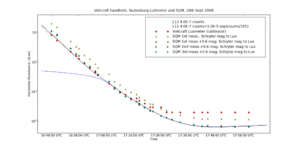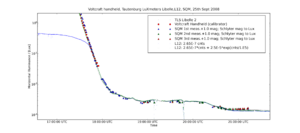Comparison to the Sky Quality Meter (SQM)
Daylight calibration and comparison to a Sky Quality Meter to 21.15 mag/arcsecond²


On September 18th and 25th I did experimental calibrations of the L12 luxmeter that is installed on the roof of the main building of the Thüringer Landessternwarte in Tautenburg. Since September 22nd L12 is installed on the same mast and at the same height within a distance of 30 cm of the "old" Libelle 2 and thus the two could be directly compared for the first time.
As calibration reference I used the handheld Voltcraft Luxmeter as usual and did quasi-simultaneous measurements with a Sky Quality Meter (SQM,#2816) borrowed from Thomas Posch. Measurements were taken as follows:
- Libelle 2: Automatically every 10s (first Tautenburg Luxmeter),
- L12: every second (new prototype series),
- Voltcraft handheld luxmeter: typically every minute down to its limit at 0.02 Lux,
- Sky Quality Meter: within a minute, usually 30s of the Voltcraft readings and in regular intervals. Up to three measurements were taken with the SQM after a first one that was ignored because I have been told that the first SQM-values shown after pressing the button are not reliable. I can confirm this, in particular once the SQM was integrating (beeping) below 0.02 lx.
I used the mag/square arcsecond to Lux conversion as given by Schlyter, in the form Lux = 10.0**(-0.40195*mag-5.5917) to convert from the SQM readings to Lux values. The conversion was checked by a similar fit due to André Müller.
To fit the so derived values from the SQM to the measurements of Libelle 2 and L12 as calibrated with the shown Voltcraft measurements I had to add 0.6 mag on the 18th of September and 1 mag on the 25th. The calibration on 18th September was done with the L12-cell in the housing of Libelle 2. The difference in the calibration factors, 4.0E-6 Lux/count for Sept 18th, inside the housing and 2.65E-6 Lux/count on Sept 25th, free on the mast, corresponds to 0.45 magnitudes. Thus the difference in offsets is likely due to the glas-housing of Libelle 2, see picture above.
The 1 mag offset between the SQM-readings converted to Lux (the difference in opening angle is accounted for) and the Luxmeter-values are likely due to the different spectral responses of the SQM and the Luxmeter. E.g. the SQM sensitivity extends further to the blue, see the section on spectral response below.
Measurements started in the afternoon with overcast (100%) sky. Clouds started to open up with the first stars shining through at 18h50 UTC and the sky started to clear rapidly from 20h30 to 20h50 UTC when no clouds remained and the visual limiting magnitude reached 6 mag as determined in UMi, with the http://sternhell.at method.
For the new L12 Luxmeter, two calibrations are shown: (1) in blue which just uses a factor to convert from counts to Lux and (2) an experimental experimental calibration that takes care of the logarithmic behaviour that was added for daylight measurements. The transition between the linear "night"-range and the "logarithmic" daylight behaviour was intentionally set near the full moon value to (1) use as much of the dynamic range of the A/D converter as possible in a linear way for the low light levels and have convenient access to light levels below 100 ulx, and (2) cover all daylight values without switching in the electronics. This feature is an intentional non-linearity in the A-D conversion and not due to the solar cell that behaves linearly.

The Luxmeters were covered near 19h10 and 19h50 UTC to check the distance to the detection limit which is beyond the bounds of the figure, deep in the mikro-Lux domain.
Overall the Luxmeters and the SQM are giving consistent results from 1 000 lx to the lowest values measured at about 1 mlx that correspond to the lowest SQM-readings of 21.15 mag/square arcsecond.
Note: The SQM above ist an SQM-L, with a full width half maximum opening angle of 20 degrees. It has to be distinguished from the original SQM with a full with half maximum opening angle of about 84 degrees, see http://unihedron.com/projects/darksky/
SQM offset and comparison to measurements with Johnson V filter
Quantitatively the offset to be expected to the SQM may be estimated from the difference of the plain cell to one with a Johnson-V-filter (1.7 mag, see Fig on the right) and the difference between SQM and Johnson V. In his Darksky Vienna 2008 talk, slide 16 Andreas Hähnel gives differences SQM-V between 0.5 and 0.6 mag for the sky and polluted sky. Assuming V as fainter we arrive at an expected offset of 1 mag between the Luxmeter and the SQM, consistent with the comparison presented here. In summary:
- L13 with V - L13 = 1.7 mag,
- SQM - V = 0.5 - 0.6 mag,
- L12 - SQM = 1 mag,
all to +/- 0.1 mag.
